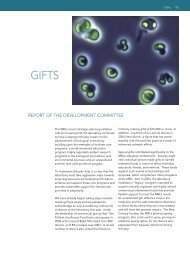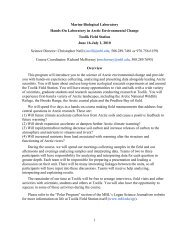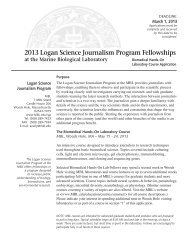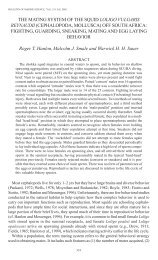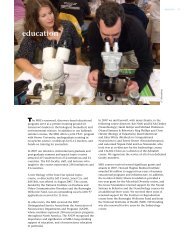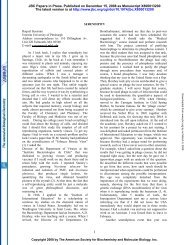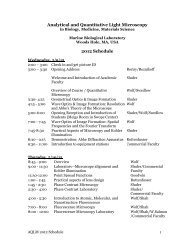An Ethogram of Body Patterning Behavior in the Biomedically and ...
An Ethogram of Body Patterning Behavior in the Biomedically and ...
An Ethogram of Body Patterning Behavior in the Biomedically and ...
You also want an ePaper? Increase the reach of your titles
YUMPU automatically turns print PDFs into web optimized ePapers that Google loves.
60 R. T. HANLON ET AL.<br />
vulgaris, L. vulgaris reynaudii, <strong>and</strong> L. forbesi all have<br />
Lateral mantle streaks; <strong>the</strong> arrangement <strong>of</strong> chromatophores<br />
<strong>in</strong> <strong>the</strong> sk<strong>in</strong> is very different <strong>and</strong> can be seen <strong>in</strong> preserved<br />
specimens. All five species seem to have highly comparable<br />
body patterns for crypsis <strong>and</strong> countershad<strong>in</strong>g, but differ-<br />
ences appear <strong>in</strong> <strong>the</strong> <strong>in</strong>traspecific signals used dur<strong>in</strong>g ago-<br />
nistic contests, courtship, <strong>and</strong> mate guard<strong>in</strong>g. Sexual signals<br />
must be specific, <strong>and</strong> <strong>the</strong>se are, <strong>the</strong>refore, <strong>the</strong> components <strong>of</strong><br />
body patterns that will cont<strong>in</strong>ue to provide unique markers,<br />
which is critical <strong>in</strong> dist<strong>in</strong>guish<strong>in</strong>g sympatric species.<br />
Conclusions<br />
Loligo pealei has an unexpectedly rich repertoire <strong>of</strong><br />
body pattern<strong>in</strong>g. <strong>An</strong>y <strong>of</strong> <strong>the</strong> 34 chromatic components<br />
can be expressed <strong>in</strong>stantly <strong>and</strong> <strong>in</strong> various comb<strong>in</strong>ations<br />
with <strong>the</strong> 5 postural <strong>and</strong> 12 locomotor components to<br />
produce each squid’s wide variety <strong>of</strong> behavior. This is a<br />
unique capacity <strong>of</strong> cephalopods because <strong>of</strong> <strong>the</strong> direct<br />
neural control <strong>of</strong> hundreds <strong>of</strong> thous<strong>and</strong>s <strong>of</strong> chromato-<br />
phore organs <strong>in</strong> <strong>the</strong> sk<strong>in</strong>. It also reflects this group’s<br />
sensory capabilities <strong>and</strong> well-developed central nervous<br />
system (Hanlon <strong>and</strong> Messenger, 1996). In L. pealei, <strong>the</strong><br />
largest portion <strong>of</strong> <strong>the</strong>se visual signals seem to be used for<br />
<strong>in</strong>traspecific communication. This is not unexpected <strong>in</strong> a<br />
species that schools for much <strong>of</strong> its brief life, but it calls<br />
<strong>in</strong>to question just how social squids are. Our f<strong>in</strong>d<strong>in</strong>gs <strong>in</strong><br />
this report can be expla<strong>in</strong>ed partly <strong>in</strong> <strong>the</strong> context <strong>of</strong> <strong>the</strong><br />
life history <strong>and</strong> ecology <strong>of</strong> this species <strong>of</strong>f Cape Cod.<br />
Loligo pealei <strong>in</strong>dividuals live less than a year (Brodziak<br />
<strong>and</strong> Macy, 1996), <strong>and</strong> <strong>the</strong>ir <strong>in</strong>shore migration each spr<strong>in</strong>g<br />
is generally thought to be l<strong>in</strong>ked to spawn<strong>in</strong>g. Off <strong>of</strong><br />
south Cape Cod (which is a prime squid fish<strong>in</strong>g area <strong>and</strong><br />
much warmer than Cape Cod Bay <strong>and</strong> o<strong>the</strong>r locations<br />
northward), <strong>the</strong> squids arrive around <strong>the</strong> first week <strong>of</strong><br />
May. The <strong>in</strong>shore trawl <strong>and</strong> weir trap fishery targets <strong>the</strong>se<br />
school<strong>in</strong>g squids, which <strong>of</strong>ten have egg mops when cap-<br />
tured, <strong>in</strong>dicat<strong>in</strong>g high levels <strong>of</strong> spawn<strong>in</strong>g. This reproduc-<br />
tive activity can be studied by divers throughout May, but<br />
it becomes <strong>in</strong>creas<strong>in</strong>gly difficult to f<strong>in</strong>d spawn<strong>in</strong>g con-<br />
gregations <strong>of</strong> squids around <strong>the</strong> sou<strong>the</strong>rn Cape <strong>and</strong> is-<br />
l<strong>and</strong>s (Nantucket <strong>and</strong> V<strong>in</strong>eyard Sounds) dur<strong>in</strong>g <strong>the</strong> sum-<br />
mer <strong>and</strong> fall, although eggs are trawled episodically<br />
throughout this time.<br />
Our div<strong>in</strong>g operations were designed to study sexual<br />
selection processes, thus our ethogram is based mostly on<br />
squids that were mature <strong>and</strong> actively engaged <strong>in</strong> agonistic<br />
contests between males, court<strong>in</strong>g, mat<strong>in</strong>g, mate guard<strong>in</strong>g,<br />
<strong>and</strong> egg lay<strong>in</strong>g. In May, many females already have sperm<br />
stored <strong>in</strong> <strong>the</strong> sem<strong>in</strong>al receptacle, <strong>and</strong> it is likely that some<br />
reproductive behavior occurs <strong>of</strong>fshore, before <strong>the</strong> squids<br />
migrate <strong>in</strong>shore. Moreover, <strong>the</strong> squids apparently spend<br />
considerable time <strong>in</strong> reproduction while <strong>in</strong>shore dur<strong>in</strong>g <strong>the</strong><br />
spr<strong>in</strong>g <strong>and</strong> summer, <strong>and</strong> thus it is not surpris<strong>in</strong>g that most <strong>of</strong><br />
<strong>the</strong> components listed <strong>in</strong> Table I are associated with repro-<br />
ductive behavior. Our many hours (more than 440) <strong>of</strong> ob-<br />
servation over three field seasons make us confident that <strong>the</strong><br />
ethogram is quite complete for <strong>the</strong>se activities <strong>and</strong> times.<br />
Whe<strong>the</strong>r o<strong>the</strong>r forms <strong>of</strong> social behavior occur rema<strong>in</strong>s to be<br />
discovered. For example, behaviors <strong>of</strong> young squids <strong>and</strong> <strong>of</strong><br />
adults not engaged <strong>in</strong> reproductive activities dur<strong>in</strong>g o<strong>the</strong>r<br />
times <strong>of</strong> <strong>the</strong> year <strong>and</strong> <strong>in</strong> different habitats have yet to be<br />
studied. However, we predict that such observations will<br />
reveal only a few new body patterns.<br />
We have <strong>in</strong>cluded polarization components <strong>in</strong> <strong>the</strong> etho-<br />
gram largely because recent discoveries have shown that L.<br />
pealei (<strong>and</strong> probably all cephalopods) uses its visual polar-<br />
ization sensitivity to detect prey (Shashar et al., 1998) <strong>and</strong><br />
produces polarization components <strong>in</strong> its sk<strong>in</strong> that could be<br />
used for <strong>in</strong>traspecific signal<strong>in</strong>g (Shashar <strong>and</strong> Hanlon, 1997;<br />
this paper, Fig. 3). Experiments on <strong>the</strong> cuttlefish Sepia<br />
<strong>of</strong>Jic<strong>in</strong>alis suggested that it could possibly use this dist<strong>in</strong>c-<br />
tive visual capability as a “hidden channel” <strong>of</strong> <strong>in</strong>traspecific<br />
communication (Shashar et al., 1996).<br />
One <strong>of</strong> our recurrent <strong>and</strong> peculiar observations while<br />
div<strong>in</strong>g was that aggregations <strong>of</strong> squids actively engaged <strong>in</strong><br />
reproductive behaviors were usually conspicuous (i.e.,<br />
bright white) ra<strong>the</strong>r than cryptic, thus potentially mak<strong>in</strong>g<br />
<strong>the</strong>m more easily detected by visual predators, which<br />
abound <strong>in</strong> <strong>the</strong> nearshore waters (e.g., mackerel, striped bass,<br />
flatfish). By help<strong>in</strong>g squids avoid predators, school<strong>in</strong>g, com-<br />
b<strong>in</strong>ed with diurnal activity, may <strong>of</strong>fset <strong>the</strong> disadvantage <strong>of</strong><br />
<strong>in</strong>creased visibility.<br />
We believe that use <strong>of</strong> our ethogram will contribute to<br />
future behavioral studies demonstrat<strong>in</strong>g that L. pealei, like<br />
o<strong>the</strong>r lolig<strong>in</strong>ids, is a species with complex sexual behavior<br />
(Hanlon et al., 1997; Hanlon <strong>and</strong> Messenger, 1996; Sauer et<br />
al., 1997) that must be understood by those charged with<br />
protect<strong>in</strong>g <strong>the</strong> resource. This species apparently has a w<strong>in</strong>-<br />
dow <strong>of</strong> opportunity for lay<strong>in</strong>g eggs that is restricted <strong>in</strong> both<br />
time (ma<strong>in</strong>ly spr<strong>in</strong>g) <strong>and</strong> space (shallow nearshore waters).<br />
Many squid fisheries worldwide target spawn<strong>in</strong>g congrega-<br />
tions, so <strong>the</strong> predation pressure on spawners is <strong>in</strong>creased<br />
(Hanlon, 1998). State <strong>and</strong> federal fishery managers estimate<br />
that stocks <strong>of</strong> L. pealei are be<strong>in</strong>g maximally exploited by<br />
commercial fish<strong>in</strong>g (NEFSC, 1995). Underst<strong>and</strong><strong>in</strong>g <strong>the</strong> mat-<br />
<strong>in</strong>g system <strong>of</strong> such short-lived species will help managers<br />
assess <strong>the</strong> true effects <strong>of</strong> fishery practices that not only<br />
capture a large number <strong>of</strong> animals but, by remov<strong>in</strong>g spawn-<br />
<strong>in</strong>g <strong>in</strong>dividuals, may disrupt <strong>the</strong> reproductive behavior <strong>of</strong><br />
<strong>in</strong>dividuals <strong>and</strong> affect <strong>the</strong> recruitment <strong>and</strong> demographic<br />
structure <strong>of</strong> populations.



